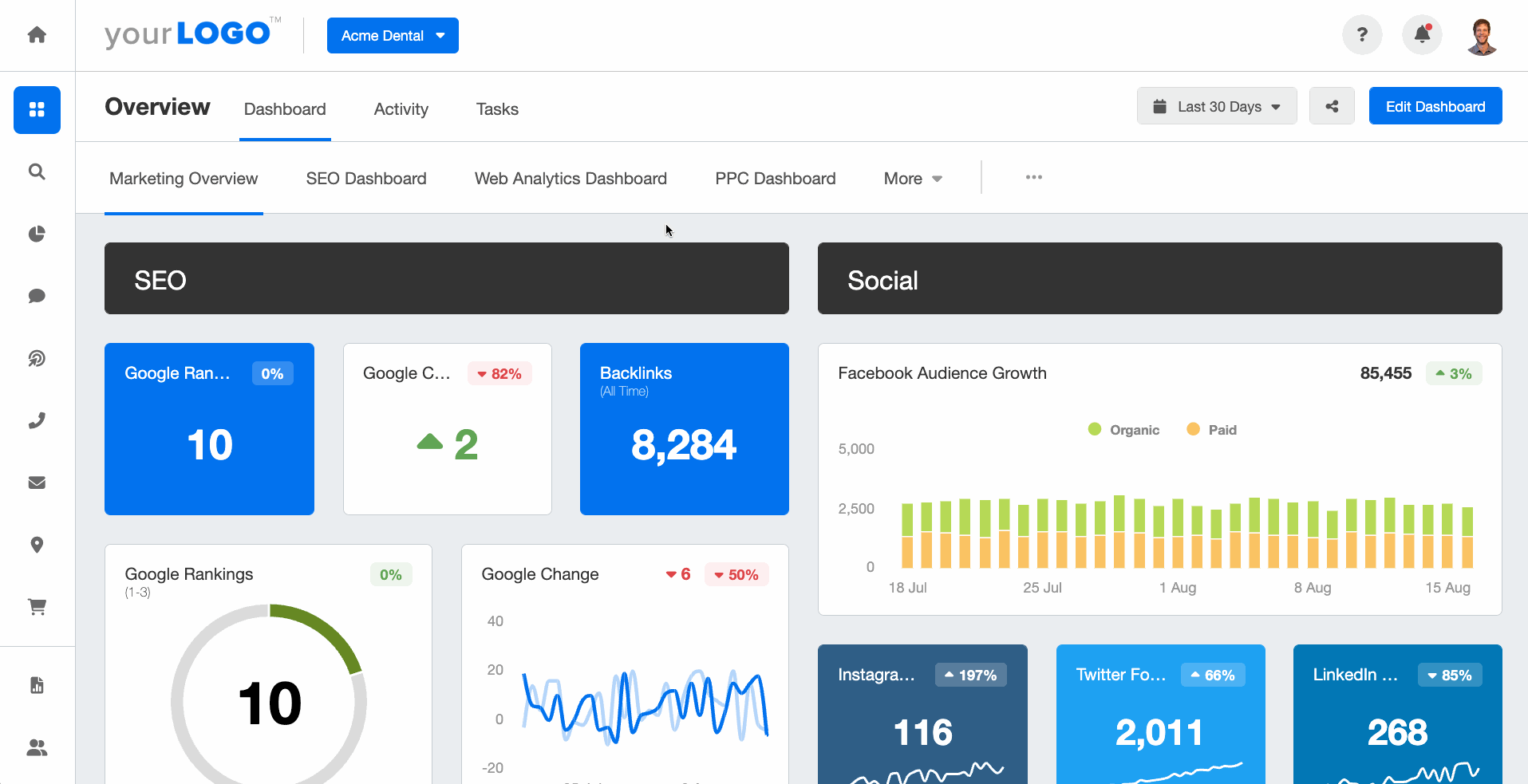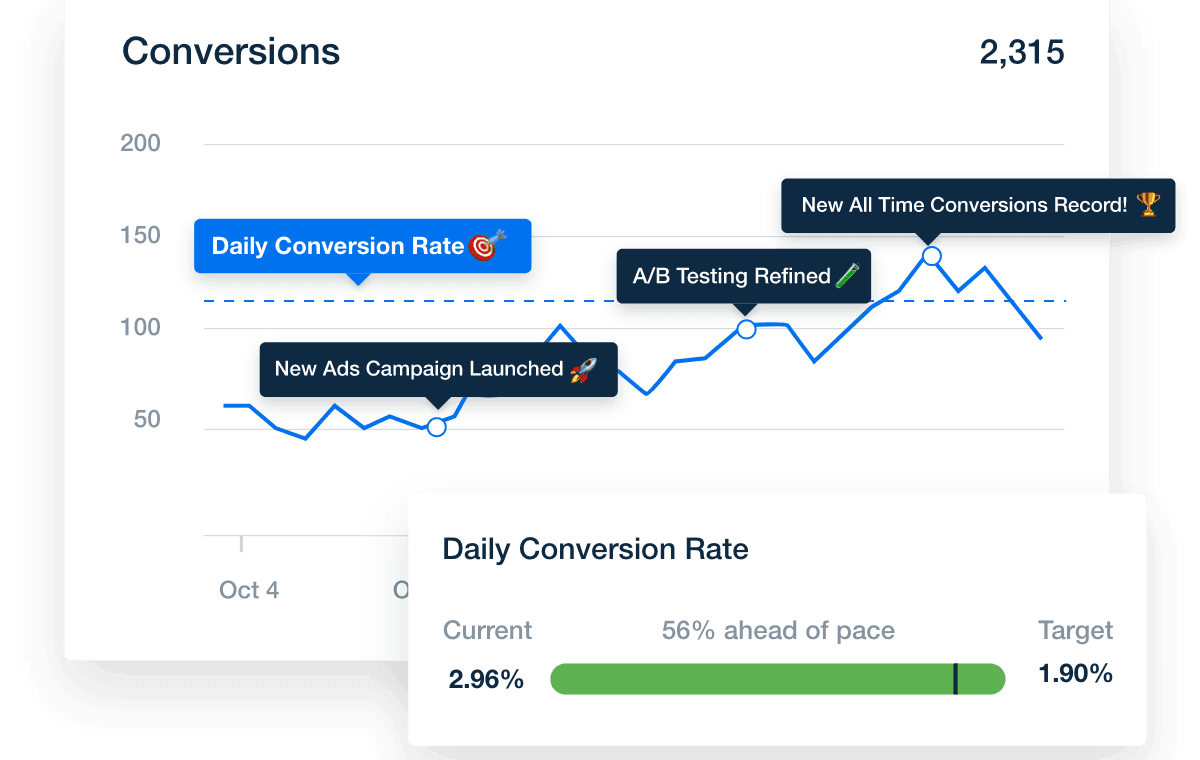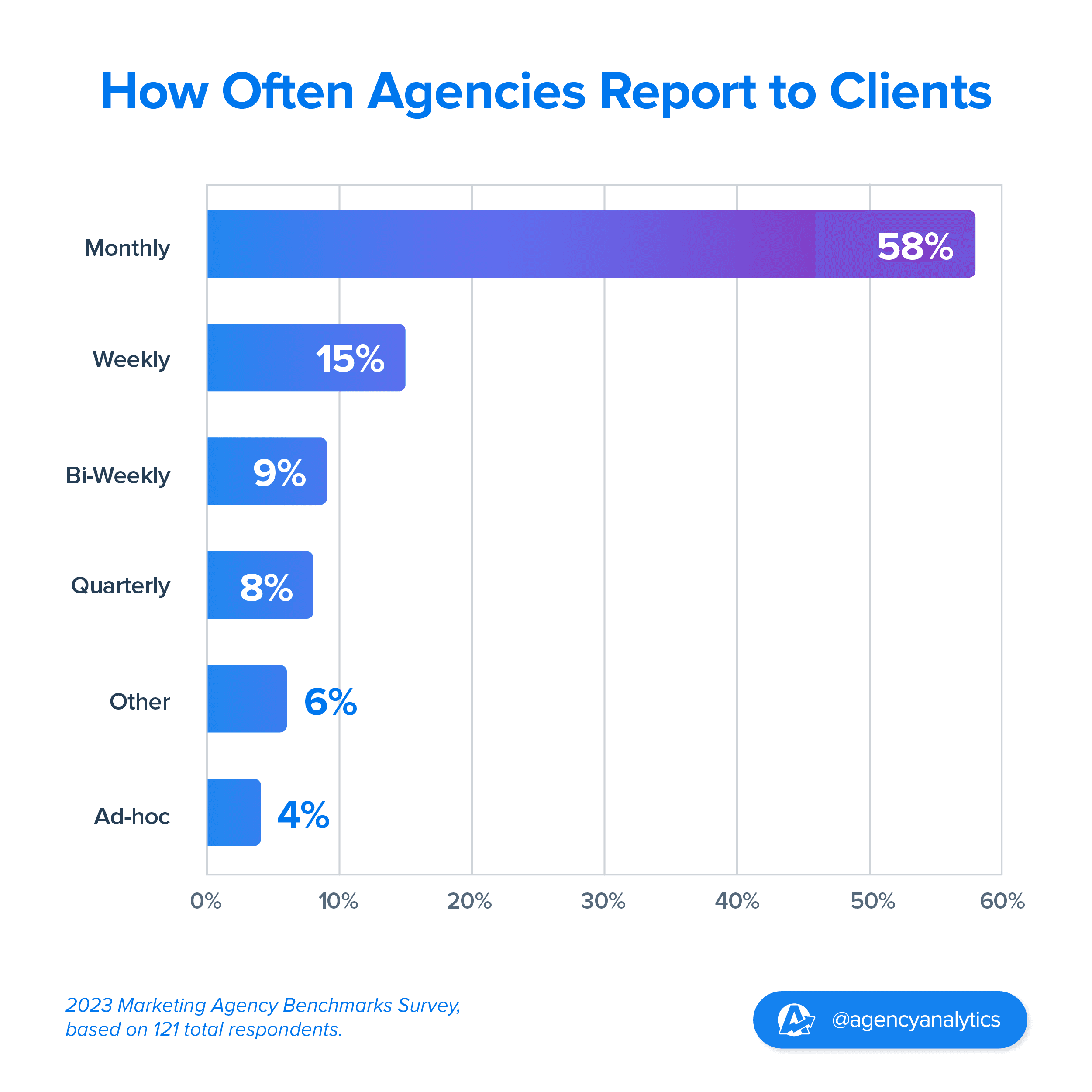Table of Contents
QUICK SUMMARY:
Discover how to craft captivating reports that resonate with clients and highlight your agency's unique insights. Gain expert advice to transform routine reports into must-see events that inform and inspire. Whether you're struggling with manual processes or inconsistent reporting, our guide will help you refine your approach, enhance client relationships, and drive meaningful engagement.
Are your client reports blending into the background? Instead of mundane data dumps, your reports should be the season’s highlight, captivating and resonating with your clients. Yet, too often, agencies let these opportunities slip by delivering reports that fail to engage or inspire—like yet another derivative sequel to a declining movie franchise.
Why settle for a forgettable matinee when your agency could be rolling out the red carpet for premiere night? Solving this problem involves leveraging every report to strengthen client relationships and demonstrate your agency's unique insight and value.
Client reporting shows the client that we're doing the work and keeps us accountable. It also allows us to check in with the client regularly to brainstorm and collaborate.
Patrice Valentine, President, ProFusion Web Solutions
This guide explores common mistakes that turn client reports from potential hits to box-office flops and how to transform them into award-winning presentations.
Get ready to make each client report a must-see event that builds anticipation and leaves your clients waiting eagerly for the next show.
What Does the Ideal Client Report Look Like?
An ideal client report goes beyond delivering just basic data—it becomes your clients' monthly success showcase.
Your client reports demonstrate your agency's deep understanding of the client’s unique needs and challenges. These reports are the pulse points where data meets narrative, creating a compelling story of progress, perspective, and potential.
Each page of the report acts as a scene in the ongoing success story of your client's business, framed through the lens of your expert analysis.
By turning routine updates into strategic sessions, the report becomes a tool for engagement. It invites clients into a dialogue, fostering a collaborative atmosphere that encourages questions, sparks ideas, and drives decision-making.
Client reporting is the backbone of our relationship with clients. Informative reporting builds trust with clients' internal management and marketing teams, letting them know that data is accurate, useful, and can be broken down into easy-to-understand and customized layouts. Proof of campaign effectiveness is important for summarizing and identifying marketing channels that work and don’t work.
Brad Fogel, CEO, Operation Technology
In essence, the ideal report doesn't just inform—it inspires. It positions your agency as a pivotal partner in your client's journey.
Reporting Mistakes That Trip Up Agency Growth
It’s easy for agencies to get tangled up in common reporting mistakes, especially when they're still doing things the old-fashioned manual way.
It’s pretty clear by now that manual reporting causes many issues, like wasting your staff’s time and creating costly errors. Beyond manual reporting, however, several other key blunders lead to missed opportunities and drag your agency down.
1. Failing To Align With Client Goals
A crucial mistake agencies make when they create reports is overlooking the importance of aligning them with what truly matters to the client. Data alone doesn’t drive decisions; relevance does. Every client has unique goals that define their success, such as increasing online engagement, boosting sales, expanding market reach, etc.
Agencies often focus on vanity metrics or what’s easiest to track and report rather than what’s most critical for the client. This makes reports unimpactful, leading to client dissatisfaction as they struggle to connect the dots between the metrics and their strategic objectives.
We base what metrics to include on what is typically the most helpful for a client to get a high-level overview of how things are doing, and then we take it a step further by including the stats that we know are KPIs for their business. We'll include more or less based on what we know about these clients and what type of communication works best for them.
Amanda Caven, Digital Marketing Strategist, Vivid Image
Solution
It's essential to understand the objectives that keep your clients up at night and ensure these are at the forefront of your reporting strategy. Use AgencyAnalytics to customize metrics that directly reflect client expectations and goals. This will ensure your reports resonate at a personal level, making them more than just data summaries—they become strategic tools that validate the client's path and shine a light on opportunities for further growth.

With AgencyAnalytics, combine marketing data to create custom metrics that provide transparency, flexibility, and even deeper insights into your reporting. Try it free today!
2. Providing Data Without Context and Insights
Another frequent oversight is presenting raw data without sufficient context or insights. Data presented in isolation overwhelms clients and diminishes an agency’s perceived value.
Cramming a bunch of data into a report doesn’t fulfill the true function of client reporting. Without context and expert analysis, clients will misinterpret the results or fail to see the bigger picture.
Our approach involves clearly articulating how specific actions improved our clients’ bottom line. Our internal mantra is to always bring the receipts. We track and report the actual effects of our strategies. Our narratives are structured to remind clients of their initial goals, outline the strategic actions we took, and demonstrate the outcomes. That way, we can illustrate a direct line from our actions to their growth.
Ruben Roel, President, Investigator Marketing
Solution
Providing context and insights transforms raw data into a compelling narrative. Use the commentary features in AgencyAnalytics to add narrative elements that tie data points together and illustrate their relevance. This will clarify the metrics' significance and provide actionable advice, guiding clients on how to use the insights to make decisions.
By weaving stories around the data, you tell the tale of your client's business journey. This story will help them see the path forward and understand the strategies that will drive their success, transforming your reports from informational to indispensable.

Show your clients their journey progress with annotations and goals in AgencyAnalytics. Make every report stand out and celebrate each campaign milestone. Start your 14-day free trial now.
3. Neglecting Visual Storytelling in Data Presentation
A visually dull report undermines the impact of the data an agency presents, making it hard for clients to engage with or understand the information.
Many agencies fall into the trap of presenting data in a straightforward, spreadsheet-like format, lacking visual appeal. This makes the data less accessible and uninteresting to clients who find the reports tedious and difficult to digest.
One specific piece of advice I would offer to marketing agencies when it comes to client reporting is to focus on creating reports that are clear, concise, and actionable.
This means using data visualization tools like charts, graphs, and tables to help clients quickly and easily understand the performance of their campaigns and websites. It also means providing context and explanations for the data presented so clients can understand what it means and how it relates to their business goals.
Daniel Dye, President, Native Rank
Solution
Embrace the power of visual storytelling to make data more accessible and engaging. Use the robust visualization tools available in AgencyAnalytics to create dynamic charts, graphs, and infographics highlighting key information and trends.
Using visual elements, you enhance the readability of your reports and strengthen their narrative, making each one an engaging experience about your client's progress and achievements.

Create stunning charts and graphics in just a few clicks with AgencyAnalytics to make your client reports compelling and easy to understand. Try it free today!
4. Failing to Showcase Long-Term Progress
A subtle yet impactful mistake in client reporting is failing to adequately showcase long-term progress. Agencies sometimes focus too much on short-term results, missing the opportunity to highlight ongoing growth and strategic successes over time.
When reports only reflect the latest metrics without acknowledging the journey, clients don’t see the full value of their investments or understand the success of long-term strategies. This leads to a skewed perception of performance, where recency bias overshadows the strategic gains made over months or years.
Professional reports allow stakeholders to track progress over time and evaluate the success of campaigns, initiatives, and other activities. This helps agencies and businesses identify trends, evaluate performance, and make data-driven decisions.
Daniel Dye, President. Native Rank
Solution
Incorporate historical data comparisons and trends to emphasize long-term success. Use AgencyAnalytics to create visual timelines and progress graphs that provide a broader perspective, reinforcing the impact of your efforts and making the case for a continued investment in your agency.
By demonstrating consistent progress, you reassure clients they’re on the right track and boost their confidence in your agency's strategic planning and execution.

Compare different time periods in your reports with AgencyAnalytics to provide context and showcase progress over time. Start your free 14-day trial today.
5. Avoiding Negative Results in Reporting
A critical mistake in client reporting is avoiding less favorable outcomes. Agencies may feel tempted to downplay setbacks or underperforming metrics, fearing negative reactions or a loss of client trust.
The truth is that avoiding negative results will erode trust over time. Clients might feel they’re not getting the full picture or that their agency isn’t honest with them. A lack of transparency leads to surprises, frustration, and diminished faith in the agency's ability to manage challenges effectively.
We faced a challenging client with a marketing strategy that didn't align with our expertise. Initially, we hesitated to challenge their decisions, fearing it might strain the relationship. However, as the campaign unfolded, it was evident that the strategy was sinking our creativity and dragging our agency's performance down.
Recognizing the importance of honesty in marketing, we took a bold step. We engaged in a transparent conversation with the client, supported by data-driven insights. We explained why their approach was counterproductive and suggested a more effective strategy tailored to their goals.
Our honesty struck a chord with the client (negatively at first), but they appreciated our partnership approach and willingness to pivot. In time, their campaigns improved substantially, and our agency's reputation and trust were solidified. Six years later, we are still servicing this client.
Jackson Sands, Marketing Manager, Sands Media
Solution
Embrace transparency as a cornerstone of your reporting strategy. Highlight both successes and areas needing improvement. Explain why certain strategies didn’t yield the expected results and what is being done to address these issues. An honest approach should include setting up alerts for significant changes in performance and preparing to discuss these shifts in scheduled reports.
Maintaining transparency builds trust with your clients, even when you deliver bad news. This demonstrates your commitment to integrity and confidence in handling challenges. It ultimately strengthens client relationships and establishes your agency as a reliable partner committed to their long-term success.
6. Failing To Report Consistently
A common oversight in client reporting is a lack of consistency in formatting, timing, and level of detail. Inconsistent reporting confuses clients and undermines their confidence in an agency's professionalism and reliability.
We get it: You’ve probably made an occasional mistake or missed deadlines once or twice. However, when reports vary significantly from one period to the next, it’s difficult for most clients to track progress and compare data over time. Inconsistent reporting detracts from the user experience and makes clients question the agency’s organizational skills and commitment to their accounts.
As a small agency, we don't have the luxury of having a lot of overhead. We need to be efficient with our time in order to be profitable. When we spend time on manual tasks, such as report generation, we are taking away time from more important tasks, such as developing and implementing marketing campaigns for our clients. This can lead to missed deadlines, unhappy clients, and lost revenue.
Ben Paine, Managing Director, Digital Nomads HQ
Solution
Standardize your reporting process to ensure consistency across all client reports. Use AgencyAnalytics' customizable report templates and scheduling features to maintain a uniform format and deliver reports on a regular, predictable basis.
Consistent reporting fosters trust and confidence by showing clients your agency is methodical and attentive to details. It establishes a rhythm that a client depends on, which is crucial for building an ongoing relationship and reinforcing your agency's reputation as a dependable partner.

AgencyAnalytics’ scheduling feature makes automating reporting and delivering your clients' business performance like clockwork easy. Try it free for 14 days.
7. Overlooking Reporting as a Tool for Upselling and Retention
One big mistake agencies make is not using reports to pitch upsells and enhance client retention. Reports are often just recaps of what's been done, missing the opportunity to suggest new services and keep clients engaged.
It's easy to get caught up in just delivering data without showing clients what else they could achieve. For instance, if a report shows a spike in website traffic but few conversions, it’s a perfect opportunity to recommend services that could improve those numbers, like conversion rate optimization.
Accurate client reporting is vital because our clients rely on knowing what campaigns worked and which didn't to help make decisions about future campaigns. Without accurate reporting, our client retention levels would be much lower.
Glenn Martin, Director of Marketing, Webspec
Solution
Use every report to identify and suggest additional services that benefit your client. Based on the data, show them clear paths for growth. For example, if the report highlights an area that could perform better with some extra attention, point it out and suggest a specific service to get the job done. By directly connecting your data insights to new service opportunities, you make your reports more than just updates—they become tools for strategic planning and partnership building.
We report detailed analytics every month to inform our clients' decisions—that’s our retention strategy. We’ve found that our retention is about three and a half times longer than that of other local agencies without using any time-based contracts.
Michael Gasser, Co-Owner & Partner, Squeeze Marketing
Squeeze Marketing also demonstrates the agency's value by including metrics in their AgencyAnalytics reports that the client hasn't yet signed up for, subtly suggesting additional services.
For example, Squeeze Marketing includes an SEO section in its reports, even if another agency is currently managing the client’s SEO. When clients see these numbers, they often inquire if Squeeze Marketing also provides SEO services.
Meanwhile, Simplified SEO Consulting takes a different approach to retention: Once clients wrap their main contract, they encourage them to sign on to a more basic ongoing maintenance tier that provides continued access to their AgencyAnalytics dashboard.
If clients stay on as alumni, they retain access to their data dashboard through AgencyAnalytics. If they choose not to stay on with an alumni package but later request additional services, we charge another onboarding fee because there's work that goes into rebuilding that dashboard.
Jessica Tappana, Founder, Simplified SEO Consulting
8. Using a “Set It and Forget It” Strategy
Another common error agencies make is adopting a "set it and forget it" strategy, especially when reporting on ongoing campaigns or services. This approach assumes that once a strategy is up and running, it doesn't need further adjustment or review.
This is a big misstep because digital marketing trends and client needs always change. For instance, a campaign that worked well during its initial months might lose effectiveness as market dynamics or audience behaviors shift. Sticking rigidly to the original plan without regular report reviews leads to stagnation and missed opportunities for optimization.
We always review the data, making specific recommendations that will be of value to the client. The data can be so in-depth that it often needs context to evaluate how effective the campaign is, what needs to be adjusted, and how it impacts the long-term goal.
Valerie Jennings, CEO, Jennings Social Media & MarTech
Solution
Regularly review and update your strategies. Use reports to track outcomes and evaluate the effectiveness of the ongoing strategy. For example, if monthly reports show declining engagement, it’s a signal to reassess the content or the platforms used.
Further, before sending reports to clients, add annotations to draw the client’s attention to specific trends or areas that are improving or declining. Remember, report customization doesn’t end when your template is complete–your team can and should customize each individual report before it’s sent to maximize client understanding of your agency’s efforts.
Encourage continuous dialogue with your clients about their campaigns. Discuss what the data shows, what’s working, and what isn’t.
9. Limiting Reporting to a Monthly Schedule
According to the AgencyAnalytics Marketing Agency Benchmark Survey, the majority of agencies report to clients on a monthly basis.

Relying solely on monthly reports is a common oversight for agencies. While it might seem efficient, this approach may delay crucial adjustments, as waiting a full month to review results might lead your campaigns to underperform or miss out on timely opportunities.
For example, if a new trend emerges or a campaign starts underperforming, waiting until the end of the month to address these changes will cost your client potential gains or savings.
We make sure our clients have access to real-time reports so they're never left in the dark. Then, on a monthly basis, we sit down with them and go over the numbers and answer any questions they may have.
Kurt Schell, President, Lithium Marketing
Solution
Implement more frequent reporting intervals, like weekly or bi-weekly updates, especially for dynamic campaigns where quick reactions are crucial. This will allow your agency to respond more effectively to performance or market condition shifts.
Additionally, use AgencyAnalytics to provide clients with 24/7 access to their data through real-time dashboards. This enhances transparency and trust by allowing you and your clients to spot trends, issues, and opportunities as they arise rather than waiting until the end of each month.
By increasing the frequency of your reports and offering real-time data access via AgencyAnalytics, you ensure that you and your clients keep campaigns agile and more likely to succeed.

Don’t make clients wait for your monthly update. Give them 24/7 access to their white label dashboards for a real-time view of campaign performance. Try AgencyAnalytics free today!
10. Skipping Video Summaries in Reports
Many agencies just send written reports and allow clients to draw their own conclusions from the data. While written reports are an invaluable tool, adding a video summary takes client communication to a whole new level. Videos will make reports clearer and more engaging for busy clients who prefer a quick visual overview instead of digging through detailed reports.
My clients are not overly technical, and providing access to their dashboard is not an effective way to show them how their SEO is progressing. Instead, I send them their customized dashboard along with a Loom video discussing the highlights.
Kelly Fitzgerald, Founder, Savvy Marketing Services
Solution
Create video summaries with tools like Loom and send them alongside your written reports. By incorporating video summaries, you make your communications more personal and engaging and help clients connect with the data to grasp the full value of your work. It’s an added touch that further emphasizes your agency’s professionalism and commitment to thorough communication.
Leverage AgencyAnalytics for Maximum Impact
Optimizing your reporting process with AgencyAnalytics will significantly enhance the efficiency and effectiveness of your client communications. By fully integrating AgencyAnalytics into your reporting workflows, you’ll streamline operations, minimize the potential for errors, and boost the overall impact of every report you deliver.
Automating data collection and report generation saves precious time spent on manual data entry and minimizes the likelihood of human error. Automation ensures data is consistently up-to-date and accurately reflected in your reports, allowing you to provide timely insights with confidence.
Prior to using AgencyAnalytics, our client reporting process was quite clunky and manual. We would generate reports from a variety of different sources, including Google Analytics, Facebook Ads, Google Ads, etc. We would then export these reports to Excel and manually compile them into a single report for each client, ensuring data, recipients, and date ranges were correct.
This process was very, very time-consuming and error-prone. It was also difficult to keep up with the latest changes to the different platforms we were using. As a result, our reports were often outdated and inaccurate.
Ben Paine, Managing Director, Digital Nomads HQ
Furthermore, with more than 80 integrations, AgencyAnalytics connects directly with your agency's preferred tools and platforms, gathering all relevant data in one place.
By leveraging AgencyAnalytics' full capabilities, you streamline your reporting processes and elevate the quality and impact of the information you deliver.
Make Your Client Reports the Star of the Show
Every report should feel like a premiere event your audience looks forward to receiving. Avoiding the same mistake on a few occasions has taught us a valuable lesson: Well-organized reports resonate with the client's goals and turn routine data delivery into an engaging narrative.
Remember, each report is a chance to have your clients on the same page, making them feel involved and appreciated, whether showing spectacular results or delivering bad news. This isn’t just about avoiding a difficult conversation; it’s about enhancing understanding and reinforcing how essential your services are to their success.
We don't just hand over reports; we spotlight the key performance indicators (KPIs) that matter most to our clients, prominently showcased with their goals in mind. Each KPI gets its own stage, making it effortless for our clients to follow their journey.
But we don't just leave them guessing. We provide context that makes those KPIs come alive. We show how shifts in these KPIs are stepping stones toward their goals. We use charts, graphs, and compelling narratives to paint a vivid picture of trends, uncover anomalies, and shine a light on opportunities hidden within the data.
Michelle van Blerck, Communications Manager, Digital Freak
By aligning your reporting strategy with AgencyAnalytics, both you and your clients will reap the benefits of a streamlined and high-impact communication process.
Enhance your reporting capabilities and transform every update into an event your clients can’t wait to experience.

Written by
Matt brings over a decade of experience managing customer-facing teams, projects, and research across a wide range of industries. He now leads the customer support and customer success departments within AgencyAnalytics.
Read more posts by Matthew DavisSee how 7,000+ marketing agencies help clients win
Free 14-day trial. No credit card required.






